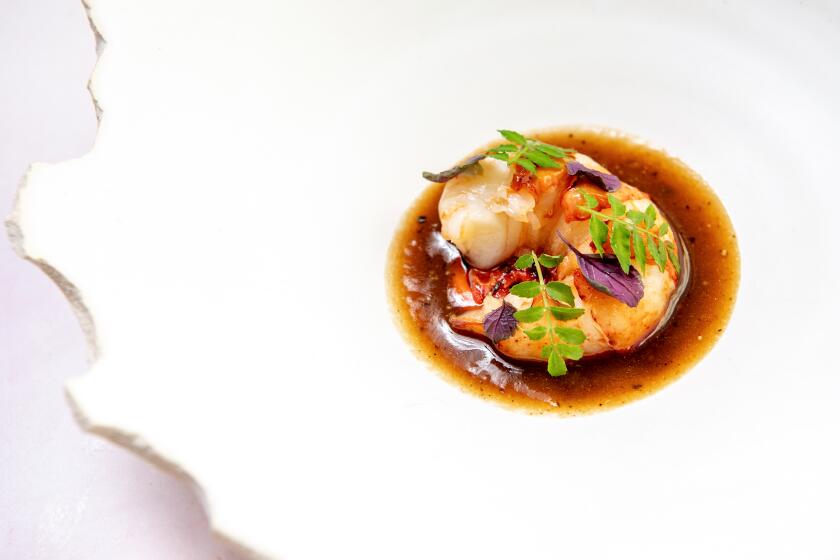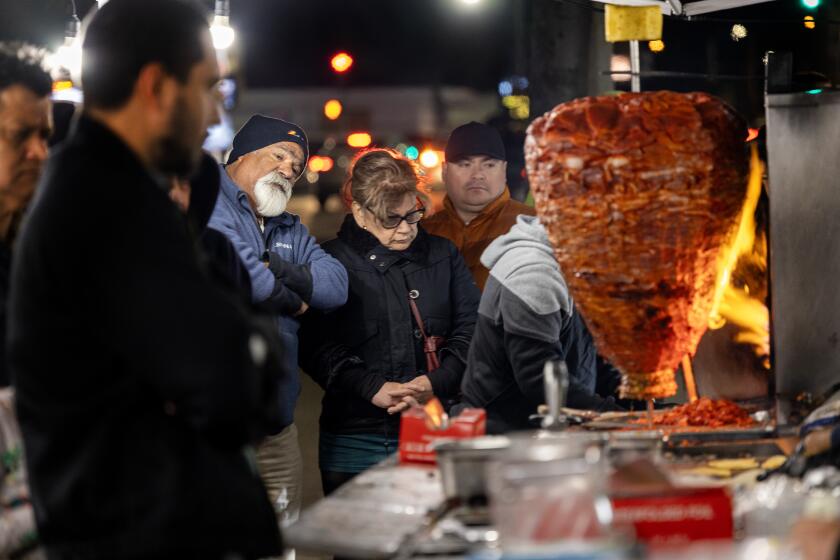San Diego Spotlight : Greek, Persian Eateries Speak Similar Language
Greece and Iran would not seem, offhand, to have a great deal in common, although they did have a famous meeting at Marathon about 2,500 years ago, when Darius led his Persian army to glorious defeat after provoking a 26-mile run that, in modern times, probably has had more reruns than “I Love Lucy.”
In between trading blows, the two armies may have swapped a few recipes. Their modern descendants share a surprisingly large number of menu items, which they eat in common with the peoples of a broad swath of territory from Northern India to Bulgaria. Flavored yogurt and eggplant dips, flat breads (pita is just one cousin in an extended family), various kebabs and, above all, rice, constitute daily fare virtually everywhere between Delhi and Sofia.
Though numerous differences exist between the menus at Cafe Athena and Kolbeh, it requires no effort to construct nearly identical three-course dinners at both these Pacific Beach restaurants. Cafe Athena, while predominantly Greek, also slips a number of Middle Eastern dishes onto the menu without identifying them as such; Kolbeh bills itself as Persian rather than Iranian, a distinction that seems semantic because it serves the cuisine of contemporary Iran.
At Cafe Athena, a no-frills pair of rooms in the neighborhood’s largest shopping center, this dinner would include dolmathes , or grape leaves stuffed with herbed rice and meat; souvlaki , a skewer of marinated chicken breast, and baklava, a flaky nut pastry sweetened with a syrup of honey and sugar. The names for the same dishes at Kolbeh are dolmeh (the stuffing excludes meat and is frankly dull), chicken kabob and baghlava .
The best plan at Cafe Athena probably is to fill up on the starter courses, which by and large are terrific, and skip the indifferent entrees; the baklava is reliable if you feel the need for something sweet before heading out the door. Vegetarians may note that the menu tilts in their direction and offers many, many more choices than do other local Greek eateries. Immense baskets of hot, fluffy pita (for some reason, it tastes better than elsewhere) accompany the various dips and spreads, including a smooth tzatziki of yogurt, minced cucumber and garlic, and skordalia , a potato-olive oil-garlic emulsion that approximates the aioli of Provence. Spanaki me skortho , also traditionally Greek, blends spinach with garlic, cilantro and lemon juice. On the Middle Eastern side, the hummos , or pureed garbanzos enriched with sesame paste, lemon and garlic, is quite delicious, and the pickle spears served on the side make novel but tasty implements for scooping it up. With the same pedigree, the baba ghannuj combines minced, charred eggplant with similar seasonings.
The extensive appetizer list also offers the usual phyllo triangles stuffed with spinach or assorted cheeses, a plate of marinated artichokes and hearts of palm, and a saganaki (cheese flamed in brandy) that really wanted a more enthusiastic squeeze of lemon than it received.
Soups include the usual avgolemeno , or egg yolk-enriched chicken broth, sadly curdled on a recent visit, and the strictly vegetarian lentil and bean soups, both quite hearty and richly flavored. The tabuleh salad again hails from the Middle East and tumbles cracked wheat with minced tomato, onion, parsley and mint; the very Greek horiatiki dresses olives, crumbled feta and chopped vegetables with a lively dressing of lemon, mint and oil.
The entrees disappointed in varying degrees. Moussaka, the great standard of Greek restaurants, was somewhat greasy, utterly innocent of eggplant and cloaked with a heavy, sticky white sauce that needed a few egg whites beaten in for the proper souffle effect. Roast leg of lamb, supposedly in Mandarin orange sauce, was served instead in a dull gravy and tasted a touch gamy; the advertised herb and garlic seasonings were hard to notice. The name of the vegetarian Imam baildi (a Turkish and Middle Eastern specialty) translates as “the priest fainted,” supposedly because this dish of eggplant stuffed with tomatoes, raisins, walnuts and seasonings tasted so good. He would not have fainted at the flat, somewhat scorched flavor of this one.
Kolbeh occupies the Mission Bay Drive premises of the long-loved, long-gone Nino’s, and cannot be said to have improved much on the decor, which now has a sort of mirrored effect; on weekends, room is made to accommodate belly dancers.
If there is a single key to Persian cuisine, it is rice, the main ingredient in many dishes and a complement to all others. The menu, in fact, finds a host of ways of mentioning this item, such as “fluffy steamed rice,” “imported fluffy rice” and “fluffy rice” (a compromise, perhaps?), among others. Kebabs perch on mountains of rice; the various specialties known as polos feature a main item of specially flavored rice with a meat garnish, and the traditional stews also are sided by plenty of rice.
Some very interesting things go on with this grain, although the cooking at Kolbeh is not generally inspiring. The must o’kheyar --yogurt with minced cucumber and mint--is typical for the genre, but mildly seasoned; the best part of the serving is the basket of bread rectangles, so thin and wrinkled they resemble parchment, that can be rolled into cigarette shapes for dipping. Torshi , a head-clearing mix of minced, aged pickles (carrots, cauliflower and eggplant included), can be eaten as appetizer or relish by anyone uncowed by this truly fierce concoction.
The majority of entrees are different styles of chicken and beef kebabs; oddly enough, Kolbeh does not offer lamb in this category. The big deals would seem to be the polo rice dishes, of which several are prepared daily from a list that includes many possibilities. The adas polo attracts with the raisins, lentils, fresh dates and saffron used to flavor the remarkably fluffy, extra-long grain rice, which by itself is delicious; Iranians go to the head of the class where rice cookery is concerned. Still, this is an awful lot of rice to eat, and the hunks of boiled chicken that garnish it are dry and dull. Lobia polo mixes the rice with green beans, diced beef and tomato sauce and does not excite the palate. The fesenjan sounds interesting and consists of fried walnuts and pomegranate sauce, again with boiled chicken and, of course, rice. Among the stews, the gheimeh is a soupy mess of yellow beans, tomato sauce and shreds of lamb shank.
CAFE ATHENA 1846 Garnet St., Pacific Beach 274-1140 Lunch and dinner daily Entrees cost $4.95 to $7.95; no wine license yet, although you may bring your own. Dinner for two, including tax and tip, about $15 to $30 Credit cards accepted
KOLBEH 4501 Mission Bay Drive, Pacific Beach 273-8171 Dinner nightly Entrees $6.95 to $13.95; dinner for two, including a glass of wine each, tax and tip, about $30 to $45 Credit cards accepted
More to Read
Eat your way across L.A.
Get our weekly Tasting Notes newsletter for reviews, news and more.
You may occasionally receive promotional content from the Los Angeles Times.






